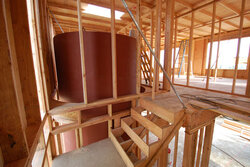Don't know if relevant, but we have Under Floor Heating in parts of the house, and Radiators in other parts. We run the radiators as hot as we can (heat is from a thermal store, so it varies from Max when boiler has charged and the store of approx 90C / 200F down to 40C / 100F when we are close to relighting the boiler)
The UFH still gives decent heat output at 40C, but its pointless putting that through the radiators.
We put water through the UFH which is just a few degrees warmer than the temperature we want in to the room (say 20C / 68F), and run the pump for long periods of time. We have hard tile floors, and it feels more comfortable to walk on them if they are not stone cold! plus we have huge thermal mass in the floors (the UFH pipe is buried deep in concrete, not in the surface screed), so we are looking to maintain that thermal mass "a bit warmer than the room". We increase the temperature, or the flow rate, if we have really cold weather, and cut it back in Autumn / Spring when the building is not losing much heat as outside temperature is mild. I expect there are weather-compensating controls which can do that sort of thing automatically, but I find that we only need a few settings / changes over the winter and I'm happy to do them manually.
I probably should alter the flow temperature to my radiators (i.e. so that it is constant), but we don't currently have that ability. It would probably help with maintaining stratification to my store, but we run our radiators ON when the boiler is lit (so that part of its heat goes into the building, and part into the store) because we have a batch log boiler and it must burn to completion (and if the store reaches Max temperature the boiler fan goes off and the wood smoulders [and is wasted]).
A friend of mind who has weather-compensation on his radiators does have that temperature adjustment, and says in the morning he reaches out of bed to feel if the radiator is hot, or warm, and then knows whether its a cold day ... or not!!



